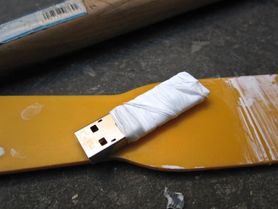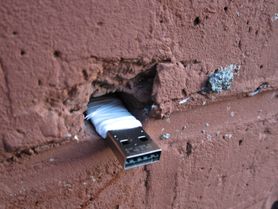This morning I installed a dead drop at 319 Scholes street in Brooklyn.
Four gigabytes worth of zeroed bits are now available for web-free semi-anonymous file exchange.
Background
Dead drops was initiated by Aram Bartholl during his residency at Eyebeam — the project involves embedding digital storage in buildings or other large, immovable objects in public space. Aram’s “Dead Drops Manifesto” follows:
Dead Drops is an anonymous, offline, peer to peer file-sharing network in public space. Anyone can access a Dead Drop and everyone may install a Dead Drop in their neighborhood/city. A Dead Drop must be public accessible. A Dead Drop inside closed buildings or private places with limited or temporary access is not a Dead Drop. A real Dead Drop mounts as read and writeable mass storage drive without any custom software. Dead Drops don’t need to be synced or connected to each other. Each Dead Drop is singular in its existence. A very beautiful Dead Drop shows only the metal sheath enclosed type-A USB plug and is cemented into walls.You would hardly notice it. Dead Drops don’t need any cables or wireless technology. Your knees on the ground or a dirty jacket on the wall is what it takes share files offline. A Dead Drop is a naked piece of passively powered Universal Serial Bus technology embedded into the city, the only true public space. In an era of growing clouds and fancy new devices without access to local files we need to rethink the freedom and distribution of data. The Dead Drops movement is on its way for change!
Free your data to the public domain in cement! Make your own Dead Drop now! Un-cloud your files today!!!
I really like this project — it sits at the intersection of the practical and the conceptual, and forces us to rethink data exchange and anonymity. In the course of researching dead drops, I read hundreds of comments from visitors to Aram’s blog posts outlining the project. A huge percentage of the comments are Henny Penny hysterics about the security implications involved in plugging your laptop into a dead drop. (Viruses! Destructive circuitry! Illegal content!) Such is the nature of creative tear-down on the web.
Nevertheless there’s something about drawing data exchange into real life that amplifies paranoia and brings out a sense of peril. If my thesis project about building a decentralized mesh-based alternative internet ends up solidifying, I’ll definitely revisit this issue of how trust works so differently in real life.
Process
Installing the drop was relatively simple. I followed the how-to guide. As fate would have it, there was already a hole in the building’s brick facade that was just the right size for a USB key. With that already sorted, I started by cracking open the key’s plastic case and mummifying it in PTFE tape for water protection:
Next I mixed up some cement, and embedded the key in the wall:
Outlook
I seeded the drive with a few files of interest, and posted it to the dead drops database — this is the 66th drop to be installed worldwide. I’ll be checking the drive every few days, and if anything interesting shows up I’ll write a post.
I’ll be interested to see how well / long it holds up to the elements, since the Eyebeam drop met an early demise after a rainstorm, and the Union Square drop was lost to vandalism.










